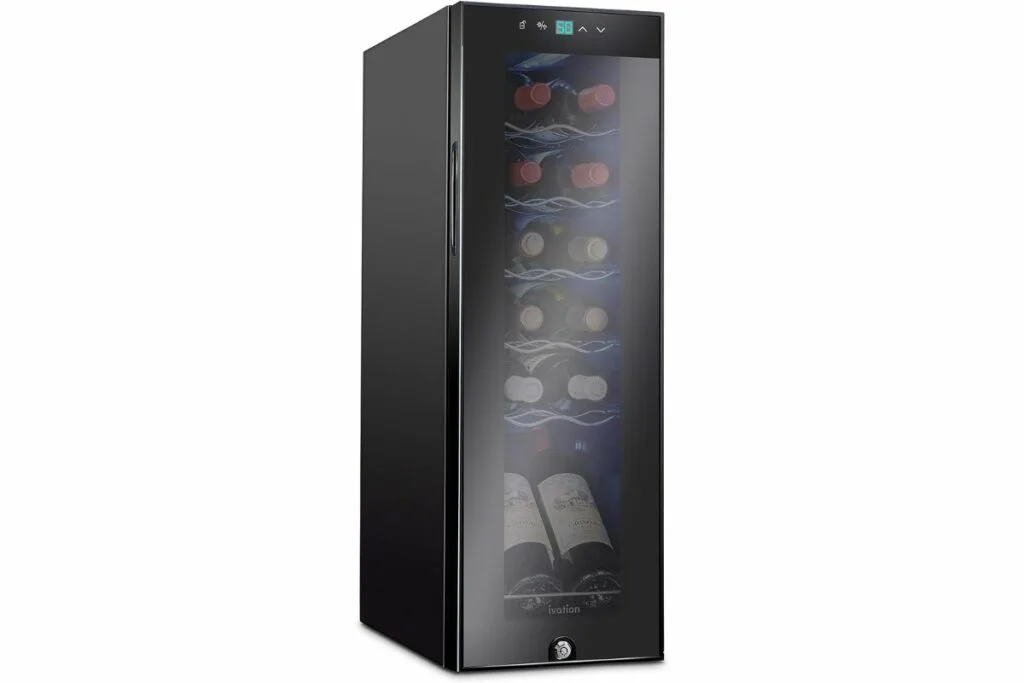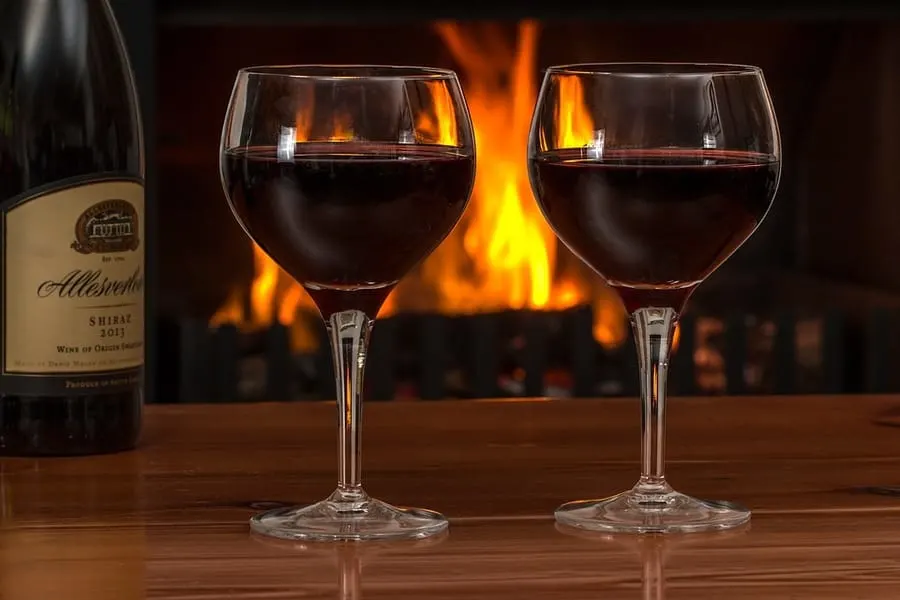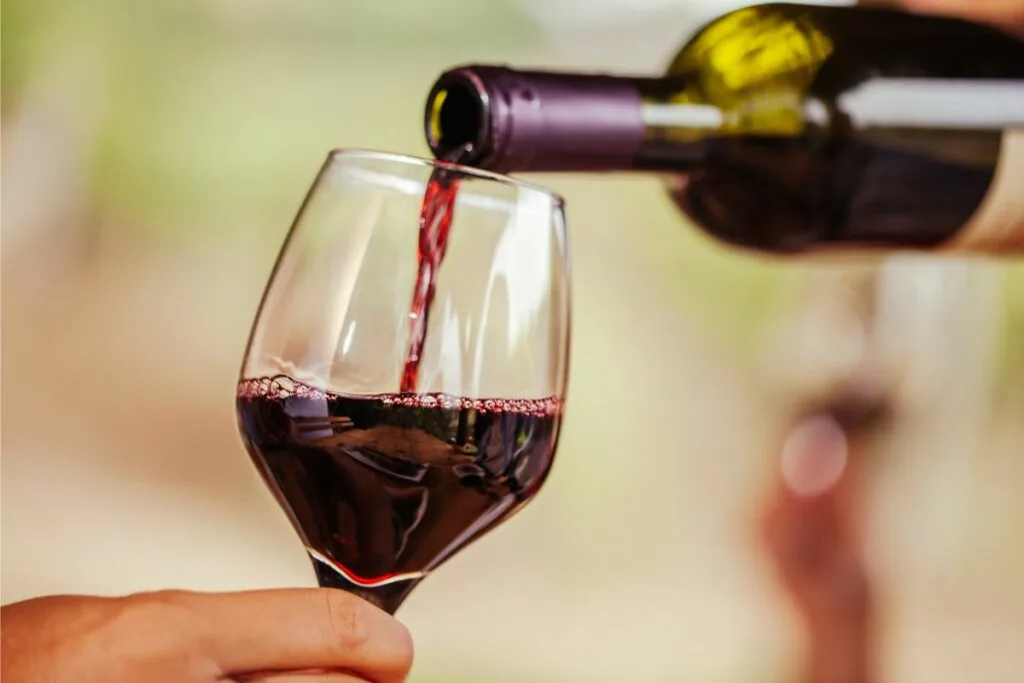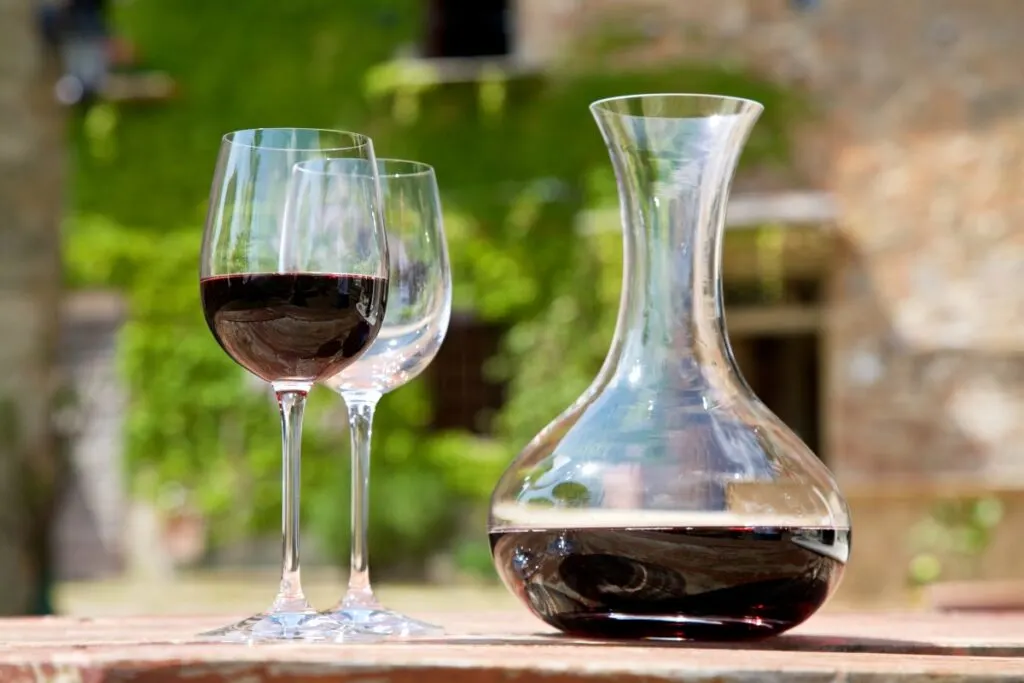As an Amazon Associate, I earn from qualifying purchases with no additional costs for you.
If you’ve recently found yourself in possession of a nice bottle of pinot noir, you may be wondering how best to store it. Pinot Noir is a complex, fruity wine known for its red color and velvety, full-bodied flavor. A nice bottle of wine can cost a large sum of money, and knowing how to properly store it until drinking time is key.
Most household Pinot Noir needs to be stored in a cool (around 55 degrees Fahrenheit) space free from direct sunlight and vibrations. Humidity, steady temperatures, and consistent conditions are also important factors. A wine cooler is usually the best bet for protecting the precious bottles within.
Whether you are a wine connoisseur or just enjoy the occasional glass, it can be helpful to know how to store your wine. The flavor and longevity of pinot noir can be greatly affected by how it is stored. Read on to learn more about the optimal conditions and options for storage.
TIP: If you want to check out the best refrigerator for wine storage, I recommend trying out the Avation (18 bottles) compressor refrigerator with Wi-fi smart app control cooling system. You can find this refrigerator by clicking here (Amazon link).
What To Consider When Storing Pinot Noir
When contemplating storing a bottle of Pinot Noir, think about when you will drink your wine and therefore how long it needs to be stored and/or if specialty storage is necessary, the cost (and ageability) of the wine, and the storage space and conditions currently available.
When it comes to deciding how to store your bottle of red wine, there are a couple of things to consider:
- When You Will Drink The Wine
If you recently purchased a bottle and plan on drinking it within the next month or so, then no special storage is required.
Simply ensuring the bottle is out of danger from extreme elements will be enough. If, however, you plan on allowing the wine to “age” for six months or even a few years, a dedicated wine storage fridge or cooler is ideal.
- The Cost of Bottle
A rule of thumb is if a bottle costs over $30, the buyer will most likely want to let it age over time before drinking it. So, if you spent a large sum on the bottle, consider giving it a special storage place to keep your investment safe.
Once you’ve determined whether or not dedicated wine storage will be needed, several key factors come into play:
- Temperature
- Humidity
- Light
- Vibration
Each of these elements is important to ensuring the flavor, quality, and aroma of your wine are protected. Further discussion on each will be provided below.
TIP: To learn how cold a wine refrigerator can get and why it is important for wine storage, check out this article. To learn the proven 8 steps for long-term wine storage, read this article.
Recommendation box: Everything you need to enjoy your wine as much as possible. All recommended products are personally tested and regularly used by experts from this website (Amazon links):
> Ivation Wine Cooler – Energy-efficient wine cooler for 18 bottles with Wi-fi smart app control cooling system.
> Wine Rack – Beautiful, elegant wood rack for up to 7 bottles and the choice of vertical or horizontal storage.
> Durand Wine Opener – Classic vintage wine opener (we like all these classic staff).
> YouYah Iceberg Wine Decanter – The most beautiful and handy wine decanter we personally use.
> Bormioli Rocco Wine Glasses – A set of eight elegant and traditional wine glasses made in Italy.
> Vintorio Wine Aerator – Simple but really useful wine aerator for a reasonable price.
> The Original Vacu Vin Wine Saver – The best wine saver on the market in a package with two vacuum stoppers and two wine servers.
And if you want to become a true connoisseur of wine, we recommend reading the book Wine Folly: The Essential Guide to Wine (Amazon link), where you will find all the information you need about winemaking, wine varieties, flavors, and much more.
What Is Pinot Noir?
Pinot noir is a red wine made from the pinot noir grape. The name comes from “pine” – because the cluster of grapes resemble a pine cone – and “dark,” referring to the deep ruby color of the skin.
Flavors and Aromas of Pinot Noir
Amongst wine enthusiasts, pinot noir is prized for its complex flavor profile and delicious aromas. More specifically, pinot noir is known for these qualities:
- Smoky, velvety, full-bodied texture
- Fruit (black cherry, plum, berries) and earthy (mushroom, leather, spicy) notes
- Minimal acidity, moderate alcohol levels, and a dry flavor
Pinot Noir Grape Sources
The pinot noir grape is most famously grown in the Bordeaux region of France, where it has long been used to create delicious red wines. Nowadays, many vineyards have taken to growing the popular grape.
The growth of pinot noir grapes and the production of delicious wines has become a global enterprise, with many wineries and tasting rooms popping up around the world.
TIP: What makes wine a fine wine? Read this guide to find out! Find out the correct way to store wine with a cork here.
Best Wine Fridge For Pinot Noir
A bottle of wine that is intended to age, or develop flavor over time, is best kept in a temperature-controlled fridge or cooler specially designed for such a purpose.
There are many options for those looking to buy a wine fridge. Most will be suitable for the storage of pinot noir, as long as they can keep a steady temperature of 55 degrees.
While many good wine fridges will do, I recommend you check out the NutriChef 120 Freestanding 12-Bottle Wine Refrigerator (link to Amazon where you can read customer reviews). I love this refrigerator and it is ideal for reds like pinot noir as well as so many other great wine options.

Wine refrigerators come in a variety of sizes and designs to fit the needs and aesthetics of the buyer. Also, prices range greatly -from the low end (around $200) up to tens of thousands of dollars.
Before investing, there are some factors to consider:
- Size of the wine fridge – do you tend to keep a dozen bottles on-hand, or is your collection much more extensive? Wine fridges range from small (6 bottles) to wine cellar worthy (100’s of bottles). If you are an avid wine collector you may want to invest in a larger fridge. The casual pinot noir enthusiast, however, may get by just fine with a 10 or 20 bottle model.
- Budget – undoubtedly the ultimate wine fridge will be out of reach due to basic economics. But not to despair! Depending on how much you can spend, a reasonable wine fridge will most likely fit your budget. Wine coolers range from just under $200 for a small, counter-top model to thousands of dollars for a built-in cabinet model that holds cases of wine. Consider how much you are willing (and able) to spend, and take it from there.
- Features – just like other appliances, wine coolers are available with a variety of features. For example, some provide multiple temperature “zones” to allow wine collectors to store a variety of wines at different temperatures. If you tend to drink a variety of different wines beyond just pinot noir, you might be interested in purchasing a cooler with two cooling zones. However, if you stick to pinot noir, then a wine fridge with just one temperature option should work fine.
- Location – before purchasing a wine fridge, it is important to consider where you will keep it. Do you have a large space? Then a larger cooler will be possible. Are you limited to just a countertop in your kitchen? Then you should search for a smaller unit that can fit the area.
Wine fridges, like other appliances, are available in a wide range of styles to fit a variety of budgets. By considering these important factors, you will be able to narrow down the options and find the wine cooler that’s just right for your needs.
TIP: This buyer’s guide discusses the best wine refrigerators for small apartments, while this article discusses how expensive wine refrigerators are to run.
Can You Store Pinot Noir In A Kitchen Refrigerator?

Of course, many wine drinkers will not seek to purchase a wine fridge due to budget or other factors. A pinot noir enthusiast may also wonder if refrigeration is even necessary, given the popular misconception that red wine is best served at room temperature.
This was true back when wine was served in French chateaus that were kept between 55-65 degrees. Nowadays homes are kept much warmer – 72 degrees seems to be optimal for most – and this would be far too warm for wine.
Red wines like pinot noir are recommended to be served at around 55 degrees. This requires some chilling, but most household refrigerators are kept much colder – about 40 degrees.
So keeping red wine in the refrigerator is not recommended unless it is a bottle you have already opened and plan on drinking within the next 24 hours. In that case, the colder temperatures will help preserve the flavor for the short term.
So when deciding whether to keep your pinot noir in the kitchen refrigerator, it is typically fine if:
- It is an inexpensive bottle
- You will be drinking it within the month
- It is already opened and you will be drinking it within the next 24 hours
If the bottle is going to be stored for a few months, it is best to keep it in a cool, dark place until you are ready to drink. At that point, you can chill it to the recommended 55 degrees by:
- Placing in the freezer for 15 minutes
- Putting it in the refrigerator for 2 hours
- Placing it in an ice bucket for 5 minutes
Following these guidelines will ensure the flavor and aroma of your bottle of pinot noir are maximized.
TIP: Read this guide to learn how to store opened white wine to make it last just a little longer. This article explains the 8 effective ways of storing wine without the cork that will work.
Do you refrigerate Pinot Noir?
Yes and no. While you’re not going to store your Pinot in the fridge long-term (this would keep it too cold), you may want to stash it there for a few minutes prior to serving, especially if it has been previously kept at room temperature.
Most homes are kept around 70 degrees F and Pinot Noir is ideally served around 55-60 degrees, so sometime in the refrigerator just before serving can help it show best in the glass.
This is also true if the bottle was just purchased from the grocery store or wine shop that day and needs to be brought down to proper serving temperature.
The proper serving temperature can help the nuances in aromatics of a fine bottle of Pinot Noir present themselves to the drinker more readily.
Storage Temperature And Humidity

As mentioned, the optimal storage temperature for pinot noir is around 55 degrees. A dedicated wine fridge will provide the conditions necessary to ensure the wine is protected from extreme temperatures. This keeps the flavors balanced – and after all, the complex flavors and aromas of pinot noir are what makes it famous.
Too Warm
If wine is kept too warm, it will age the wine too quickly and break the flavor down. Even the typical room temperature of around 72 degrees is not ideal, as it can cause the complexities of the wine to decay. When storing pinot noir, it is best to keep it around 55 degrees, and this typically requires refrigeration.
Too Cool
On the other hand, the cold confines of the kitchen refrigerator – which is usually set to somewhere around 40 degrees – can cause all kinds of problems for a complex wine like pinot noir.
In extreme cold, the wine will not age, but instead, go into “hibernation mode.” The flavor will be stuck in time, never developing the rich, full-bodied texture that pinot noir is intended to have.
Humidity
Besides temperature, humidity is another key factor in maintaining the quality of a bottle of pinot noir. If the bottle has a synthetic cork or a screw top, humidity is not too much of an issue. However, if the bottle is corked with natural cork – one made from tree bark – then it is extremely important to store it properly.
A natural cork that dries out, for example, can lead to wine spoiling. Wine spoils when oxygen is allowed into the bottle. If a cork is chilled and dried out, as happens in a standard kitchen refrigerator over time, it will contract.
When it contracts, it pulls away just slightly from the bottle. This allows air – and oxygen – into the bottle. The result will be a pinot noir with an offbeat flavor.
A wine fridge controls not only temperature but humidity, creating the optimal conditions for the wine bottle and cork. Also, most wine fridges store the bottles on their side. This is also to help natural corks stay moist during storage. A dry cork can spell bad news for a nice bottle of wine.
Light Exposure
Another factor that is seldom considered, but just as important, is the exposure of the wine bottle to the light. Pinot noir is a deep, ruby red color.
This is one of its characteristics that is so admired by collectors and drinkers alike. It is often stored in clear glass bottles, allowing wine lovers to appreciate the color. Clear glass, however, does not provide any protection against light.
When exposed to light, over time the bottle will experience something called “light strike.” When light hits a bottle of wine, even if only for a few hours, the rays can break down acids in the wine.
These damaged acids will then create an unpleasant aroma and flavor – sometimes described as musty or moldy. Not ideal in a fruity wine.
Vibration
An element that many wine drinkers might not consider when storing their wine is vibrations. The small amounts of movement caused by things like doors slamming, laundry rotating in a dryer, or footsteps can impact the quality of the wine.
Vibrations agitate the natural sediments that occur in wine, speeding up chemical reactions. These reactions produce off-flavors, ruining a bottle of even the finest pinot.
Is It Ok To Store Pinot Noir At Room Temperature?
Unopened bottles can be stored at room temperature in the short term (up to a few months). Longer than that and they should be moved to cooler storage. Bottles stored at room temp can then be stashed in the fridge for a couple of hours to lower them to proper serving temperature prior to opening.
Many wine drinkers believe that red wines are best served at room temperature – but as previously mentioned, this is a myth. However, many wine drinkers may still prefer to drink their pinot noir at room temperature. They may choose to do so because:
- They are used to it
- They prefer the flavor
- A wine fridge is not in the budget
- There is no refrigeration available (for example, when on a picnic)
In these cases, there is certainly no “wine police” who will come to monitor the temperature of your pinot noir. The choice is left up to the drinker to determine which way they choose to enjoy their wine.
And if the bottle is inexpensive, the flavors will probably not be complex enough to warrant a costly wine fridge. The best thing to do, no matter the temperature of the wine, is to enjoy the experience and the company you are with.
TIP: Most wines go bad once you pop the cork within a day or so. But a Coravin Wine Preservation system (available for a great price on Amazon) can extend the life of your opened wine for weeks or even months. It is awesome. You should check it out to see if it fits your lifestyle.
Open Bottle vs. Closed Bottle Storage

Once the bottle of Pinot Noir is opened, the next challenge is deciding how to store any remaining wine. Sometimes the drinker only pours one glass, leaving a large amount left in the bottle. What are the recommendations for storing the remaining Pinot Noir?
The answer varies, but most agree that storing an open bottle in the fridge is fine – for a short period. It is best to drink any remaining wine within 24 hours to experience the flavors of the wine before they break down in the cold refrigerator.
To store an open bottle of wine in the kitchen refrigerator, it is recommended you:
- Pour remaining wine into a smaller bottle, if possible
- Seal the wine (with the cork or a special wine stopper, for example)
- Place it upright in the refrigerator
- Drink within 24 hours
The reason it is recommended the wine be poured into a small bottle before storing is because of oxygen. As mentioned, oxygen destroys the flavor and aroma over time, and if a small amount of wine is being stored in a large, sealed bottle, then the air in the bottle is affecting the wine. A smaller bottle means less air, which in turn protects the pinot noir from oxidation.
TIP: Are you interested in buying a wine stopper? We’ve personally tried and recommend buying one of these wine stoppers (Amazon links):
- The Original Vacu Vin Wine Saver: Our top choice. Very easy-to-use wine stopper/saver. You can enjoy a glass of fresh wine whenever you want without worrying about wasting any.
- EZBASICS Wine Saver: Great alternative to Original Vacu Vin Saver. This wine stopper keeps the flavor of wine for up to one week.
- Champagne Stopper by MiTBA: Wine stoppers for sparkling wines are different. This wine stopper seals your bottle and increases the pressure so your beverage’s bubbles won’t go to waste.
How Long Can You Store Pinot Noir?
There are so many factors that contribute to the longevity of wine, but it mostly comes down to quality and style – was this a wine crafted with the intention of aging, or was it meant for early drinking? All of this is, of course, dependent on proper storage.
The price point is usually a good indication (less than $30 or so, drink now, $30-80 is a gray area with Pinot Noir, and beyond is often age-worthy).
The producer’s website is a great resource if you’re not sure; wines meant to age often have that information along with the expected drinking window included on the page. The best Pinots from Burgundy can age for decades, while most grocery store finds are meant for no more than a year or two on the shelf.
How Long Does Pinot Noir Last in the Fridge?
An opened bottle of Pinot Noir can last for a day or two in the refrigerator as long as it is properly sealed. Allow your own palate and preferences to be your guide – if you’re still enjoying the wine, go for it! If something seems off, it is probably time to say goodbye to the rest of the bottle.
Oxygen is the enemy of wine once a bottle is open, so an airtight seal is essential for preserving the wine – a silicone bottle stopper is best. Avoid reusing the porous cork, which allows airflow, or a vacuum seal system, which removes aromatics along with the air it pumps out.
Let the wine warm up slightly before serving if it has been refrigerated for several hours or days. Pinot Noir is an especially delicate wine with less tannin than say, Cabernet Sauvignon, so it may not last as long.
Ideal Storage for Pinot Noir
Overall, it is recommended that a nice bottle – $30 or more, for example – be kept in a cool environment with controlled humidity. This typically means the purchase of a dedicated wine fridge or cooler.
If you are a casual drinker of pinot noir, picking up a bottle at the grocery store to pair with dinner that night, then a few minutes in the freezer or bucket of ice will be just fine to bring your wine to optimal drinking temperature.
If the decision to purchase a wine fridge is made, the next steps are to consider the various factors and options that are available. Price, for example, is usually the main deal-breaker, followed by size. Whatever you choose, there is sure to be a model that will work for your needs.
TIP: Check out this page for a complete list of wine products and accessories I love. You’ll find my recommendations for wine refrigerators, decanters, and aerators and the best place to buy wine online. Click here to see the complete listing.

